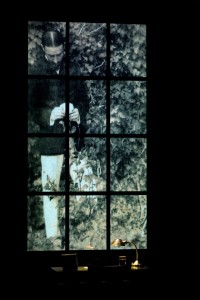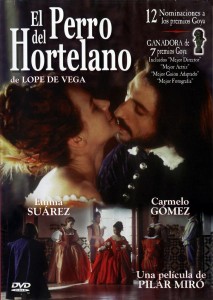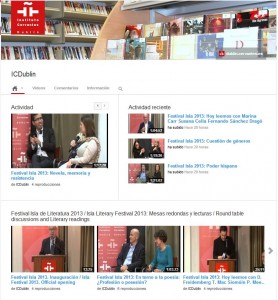Blog del Instituto Cervantes de Dublín
Torre Martello
Diario de un poeta recién casado / Diary of a Newlywed Poet
 Diario de un poeta recién casado es «una breve guía de amor por tierra, mar y cielo» escrito por el premio Nobel de literatura Juan Ramón Jiménez durante su primer viaje a Nueva York. Este viaje iniciático lo reúne con su musa, Zenobia Camprubí, quien pronto se convertirá en su mujer a pesar de haber rechazado en otras ocasiones las propuestas amorosas del poeta.
Diario de un poeta recién casado es «una breve guía de amor por tierra, mar y cielo» escrito por el premio Nobel de literatura Juan Ramón Jiménez durante su primer viaje a Nueva York. Este viaje iniciático lo reúne con su musa, Zenobia Camprubí, quien pronto se convertirá en su mujer a pesar de haber rechazado en otras ocasiones las propuestas amorosas del poeta.
Juan Ramón Jiménez inaugura con esta obra un mundo nuevo de posibilidades para el verso libre en español, y construye el ritmo de sus poemas inspirándose en los movimientos del mar.
Este Diario es un espectáculo organizado en colaboración con la compañía Teatro de la Abadía, dirigido por el conocido y multipremiado actor José Luis Gómez. En él, «Gómez encarna a un Juan Ramón aislado y solitario, viviendo la cadencia de su verso y la naturaleza única e íntima de cada palabra. Y, sin embargo, todo, el patio de butacas, las paredes del teatro, todo hasta el infinito / se colma de una esencia / inmensa y viva».
El espectáculo tendrá lugar en el histórico Smock Alley Theatre (Boys School). Una ocasión única para aproximarse al texto original en la voz de uno de los mejores actores de la escena teatral española. Una representación que se incluye en las celebraciones del mes de Juan Ramón en el Instituto Cervantes de Dublín, en el que conmemoramos el centenario de la primera publicación de Platero y yo, la obra más universal de Juan Ramón y el texto en español más traducido a nivel mundial después de El Quijote, de Miguel de Cervantes.
¿Dónde? Smock Alley Theatre, Exchange Street Lwr, Temple Bar, Dublin 2
¿Cuándo? El 5 de noviembre a las 7 de la tarde.
Entrada libre hasta cubrir aforo.
Reservas en: reservas.dublin@cervantes.es
Espectáculo en español con sobretítulos en inglés.
Organised by: Instituto Cervantes Dublin in collaboration with Teatro de la Abadía (Madrid)
Nota de prensa de Miriam Abuin (prendub@cervantes.es)
Diary of a Newlywed Poet is “a guidebook to love through the land, the sea and the sky”. Nobel Prize winner Juan Ramón Jiménez writes during his first trip to New York. This initiation journey reunites him with Zenobia Camprubí, soon to become his wife, but who had refused to accept his attentions and courtship in various occasions.
Juan Ramón Jiménez inaugurates with his work a world of possibilities for the free verse in Spanish, and constructs the rhythm in his poems inspired by the movements of the sea.
Diary… is a show organised in collaboration with the prominent theatre company, Teatro de La Abadía, led by renowned actor and director José Luis Gómez. “Gómez incarnates a solitary and isolated Juan Ramón, living on the cadence of his verse and the unique and intimate nature of his words. But, surprisingly enough, everything, the stall, the theatre walls, everything, even the infinite / becomes suffused with an immense / and living essence”. The show will take place in the historic Smock Alley Theatre (Boys School).
This is an exceptional occasion to enjoy and approach the original text in the voice of one of the best actors from the current Spanish theatre scene. Diary… is included in Juan Ramón Jiménez´s Month, a series of events prepared by Instituto Cervantes for the month of November to commemorate the centenary of the first publication of Platero y yo, Juan Ramón Jiménez’s universal work and most translated text from Spanish after Don Quixote.
Location: Smock Alley Theatre, Exchange Street Lwr, Temple Bar, Dublin 2
Date: 5th November
Time: 7pm
Free Admission but limited places available.
Please book your ticket at reservas.dublin@cervantes.es
Languages: Spanish with English surtitles.
Organised by: Instituto Cervantes Dublin in collaboration with Teatro de la Abadía (Madrid)
Press release by: Miriam Abuin (prendub@cervantes.es)
Film screening: El perro del hortelano
 El ciclo de cine “Un libro, una película” llega a su fin este miércoles a las seis de la tarde con la película “El perro del hortelano”.
El ciclo de cine “Un libro, una película” llega a su fin este miércoles a las seis de la tarde con la película “El perro del hortelano”.
Os ofrecemos la adaptación de una comedia palatina de Lope de Vega (1562-1635). Su título hace alusión al refrán El perro del hortelano no come ni deja comer.
Cuenta la historia de Diana, condesa de Belflor, una joven perspicaz, impulsiva e inteligente. Está enamorada de Teodoro, su secretario, pero comprueba que éste ya está comprometido con la dama Marcela. Movida por los celos y la envidia, todo su afán se centra en separar a los dos enamorados.
El autor de la obra de teatro en la que se basa la película es Lope de Vega (Madrid, 1562). Poeta, novelista y el más grande dramaturgo español. Cultivó todo tipo de géneros vigentes en su tiempo, dando además forma a la comedia. Escribió unas 1.500 obras teatrales entre las que se encuentran auténticas joyas de la literatura universal de las que se conservan 426.
Pilar Miró (Madrid, 1940) es una reconocida directora de cine española. En 1982 ocupó el cargo de Directora General de Cinematografía y entre 1986 y 1989 dirigió la Radio y Televisión Pública Española. Su actividad posterior se diversificó entre la dirección de teatro y de ópera y su carrera cinematográfica, siendo su última producción El perro del hortelano (1996).
A la proyección le seguirá un debate dirigido a todo tipo de público.
The film series “One film, one Book” ends this Wednesday at 6pm with the screening of the film “El perro del hortelano”.
Based on a comedy by Lope de Vega (1562-1635). The title refers to a Spanish saying equivalent to ‘People often grudge others what they cannot enjoy themselves’.
The story is about Diana, the Countess of Belflor, is an intelligent, impulsive woman in love with her secretary, Teodoro. He is engaged to Marcela, one of the countess’s ladies in waiting. When the countess finds out about the engagement, driven by jealousy, she does everything possible to separate the lovers.
Lope de Vega (Madrid, 1562) is the most prominent Spanish playwright. He also wrote poems and novels, exploring all literary genres of his times. Furthermore, he was one of the forerunners of the comedy. He wrote about 1500 plays, from which only 426 have been kept, representing a treasury of world literature.
Pilar Miró (Madrid, 1940) is a renowned Spanish filmmaker. In 1982 she became General Director for Filmmaking and from 1986 to 1989 she headed the Spanish Public Broadcasting. Her subsequent career diversified between theatre and opera direction and filmmaking. The dog in the Manger (1996) is her last film.
The screeening will be followed by an open discussion.



